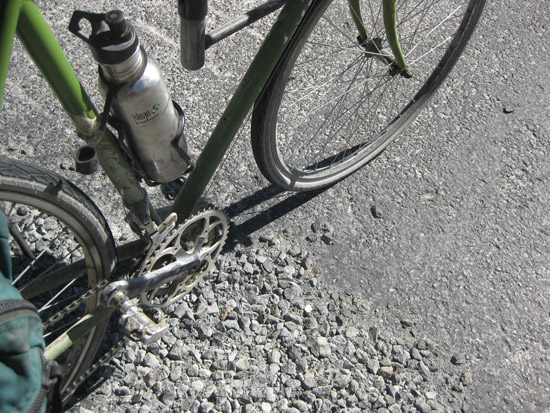The Long and Bumpy Road to Cappadocia
Of all the bizarre landscapes created by water, wind and time, Cappadocia is among the strangest
/https://tf-cmsv2-smithsonianmag-media.s3.amazonaws.com/filer/20111013103010cappadocia-village-men-small.jpg)
This trip began amorphously, with just a bicycle, a strange land and two months to kill, but it has assumed a shape: that of a long, slow expedition to Cappadocia. Of all bizarre landscapes created by water, wind and time, Cappadocia is among the strangest. Here, bleak desert mesas plunge into canyons studded with spires like giant morels. Christians once hid from Roman tormenters in underground cities, which remain today. Towns of cave huts were once carved into the rock. Volcanoes reside on the horizon, so wonderful to watch at sunset, and many an American desert aficionado might wonder if Edward Abbey didn’t get out enough.
But to get to Cappadocia, I must ride halfway across Turkey—the world’s eighth continent if ever there was a seventh. Cappadocia lies smack in Turkey’s center, where distances are great and torturous, the land wide, barren and dry, the mountains bald and scorched. Since leaving the Koroglu Mountains, where 200 square miles could have kept me entertained for a week had I enough food, I’ve been moving 70 to 80 miles a day, mostly against headwinds or crosswinds, as I try to put the sluggish scenery behind me. I hold my breath and charge through Ankara, Turkey’s capital of four million-plus people. I emerge on the south side four hours later, my face gritty with soot, and I continue southeastward on highway D260 into the desert.
![]()

Relief comes from below as rocky asphalt gives way to smoothly paved ground.
The asphalt is awful. Half the roadways in Turkey are paved with walnut-sized rocks that jut a half-inch out of the tar and have been rattling my brain and bones for the past 400 miles. Many dirt roads are smoother, and this asphalt can slow a cyclist to a crawl.
After five days of camping, I pay for a room just outside the city of Kirsehir. I awake early for my last ride to Cappadocia, but the door out is locked and I’m alone, stuck inside this grimy hovel, the manager snoring somewhere far away with the key in his pocket. Nature is calling, too, and though I hold off as long as I can, I eventually succumb and face the abominable hole in the floor known as the Eastern toilet. The hotel manager arrives at 9 a.m. to liberate me.
Late in the morning, I stop to eat a melon, one of my favorite daily rituals. I roll into a village square at a vacant bench under a tree. One by one, they materialize around me: the idle village men. They are unremittingly friendly but without regard for one’s privacy. They stop to have a long stare at me, and they murmur among themselves in their growing circle. “Say, Sam, where do you reckon this fellow is from?” “Germany, perhaps? I’m just puzzling why he doesn’t wear heavy trousers, a long-sleeved shirt, leather clogs on his feet and a woolen vest like we do. He looks dog-tired, doesn’t he? Let’s ask him a hundred questions!”
“Aren’t you cold wearing shorts and a T-shirt?” one exclaims. The whole group giggles awkwardly.
“It’s 75 degrees in the shade!” I sputter.
“Germany? England?” another man asks.
“America,” I sigh. “Speak English. Little Turkish. Tired, so tired. Your asphalt is killing me and I just want some silence. Disperse now. Thank you.”
Younger boys arrive, too, shouting as surely as a dog barks, “Hel-lo! Hel-lo!”
“Why are you alone?” the men persist. “Don’t you have a wife and a bunch of kids?” “Why doesn’t your bike have a motor?” There are now 10 of them (all men and boys; women and girls go mostly unseen in the Turkish village country).
“Çay!?” one man suggests brightly.
“Spare me.”
There is no choice but to pack the melon up and run for it. In the final miles, I find a beautiful side road that cuts straight to Avanos, at the northern corner of Cappadocias. Not only is this road small and quiet, it is a shortcut, eliminating 20 kilometers of freeway from my ride. Better still, it’s paved smoothly, and I fly like I’m on rails. The land begins to change as signs of geologic turmoil appear. In the sunflower and tomato fields, tilted layered rock breaks the surface. Some protrusions have gaping holes through them. Thirty miles away, I see the 13,000-foot Mount Erciyes in the hot haze. Somewhere before there, just 10 miles as the crow flies, still unseen but just under my nose, is the landscape of legend: Cappadocia.
Planning Your Next Trip?
Explore great travel deals
Smithsonian magazine participates in affiliate link advertising programs. If you purchase an item through these links, we receive a commission.
/https://tf-cmsv2-smithsonianmag-media.s3.amazonaws.com/accounts/headshot/Off-Road-alastair-bland-240.jpg)
/https://tf-cmsv2-smithsonianmag-media.s3.amazonaws.com/accounts/headshot/Off-Road-alastair-bland-240.jpg)